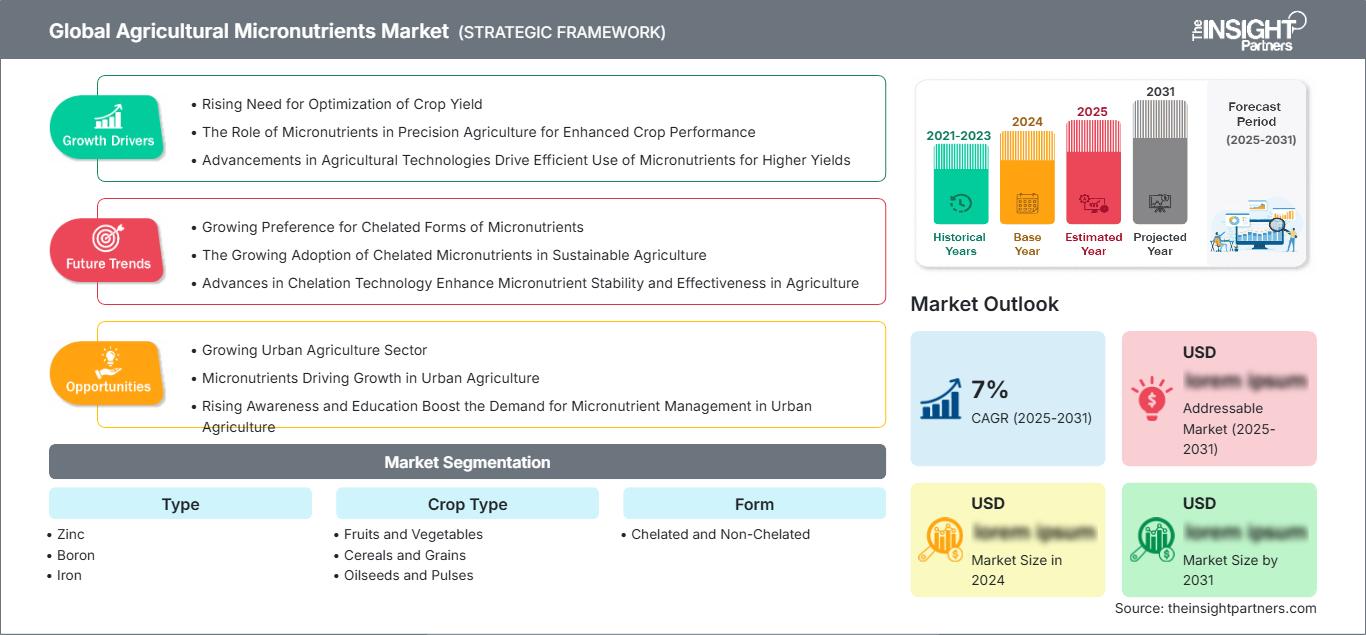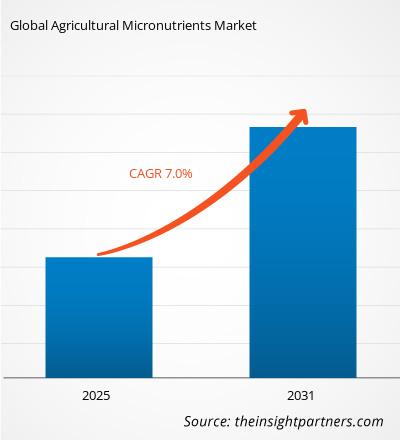Se espera que el mercado de micronutrientes agrícolas registre una CAGR del 7% entre 2025 y 2031, con un tamaño de mercado que se expandirá de US$ XX millones en 2024 a US$ XX millones en 2031.
El informe está segmentado por tipo (zinc, boro, hierro, molibdeno, cobre, manganeso y otros). Además, presenta un análisis por tipo de cultivo (frutas y hortalizas, cereales, oleaginosas y legumbres, entre otros). El informe, según su forma, se segmenta en quelado y no quelado. El informe, según su modo de aplicación, se segmenta en suelo, foliar, fertirrigación y otros. El análisis global se desglosa a nivel regional y por países principales. El informe ofrece el valor en USD para el análisis y los segmentos mencionados.
Propósito del Informe
El informe "Mercado de Micronutrientes Agrícolas" de The Insight Partners busca describir el panorama actual y el crecimiento futuro, los principales factores impulsores, los desafíos y las oportunidades. Esto proporcionará información a diversas partes interesadas del negocio, como:
- Proveedores/fabricantes de tecnología: Para comprender la dinámica cambiante del mercado y conocer las oportunidades potenciales de crecimiento, lo que les permitirá tomar decisiones estratégicas informadas.
- Inversores: Realizar un análisis exhaustivo de tendencias respecto a la tasa de crecimiento del mercado, las proyecciones financieras del mercado y las oportunidades que existen en toda la cadena de valor.
- Órganos reguladores: Regular las políticas y las actividades policiales en el mercado con el objetivo de minimizar el abuso, preservar la confianza de los inversores y defender la integridad y estabilidad del mercado.
Segmentación del mercado de micronutrientes agrícolas
Tipo
- Zinc
- Boro
- Hierro
- Molibdeno
- Cobre
- Manganeso
Tipo de cultivo
- Frutas y verduras
- Cereales y granos
- Semillas oleaginosas y legumbres
Forma
- Quelado y no quelado
Geografía
- América del norte
- Europa
- Asia-Pacífico
- América del Sur y Central
- Oriente Medio y África
Recibirá personalización de cualquier informe, sin cargo, incluidas partes de este informe o análisis a nivel de país, paquete de datos de Excel, y además aprovechará grandes ofertas y descuentos para empresas emergentes y universidades.
Mercado mundial de micronutrientes agrícolas: perspectivas estratégicas

-
Obtenga las principales tendencias clave del mercado de este informe.Esta muestra GRATUITA incluirá análisis de datos, desde tendencias del mercado hasta estimaciones y pronósticos.
Factores que impulsan el crecimiento del mercado de micronutrientes agrícolas
- Creciente necesidad de optimizar el rendimiento de los cultivos: Uno de los grandes impactos que se le otorgará al mercado de micronutrientes agrícolas es el aumento de la optimización del rendimiento. Esto se derivará de la tendencia de los agricultores a mejorar la productividad y la calidad de los cultivos, lo que generará una mayor demanda de micronutrientes como el zinc, el hierro y el manganeso. Este ha sido uno de los componentes críticos para la salud y el rendimiento de las plantas, especialmente en condiciones ambientales adversas.
- El papel de los micronutrientes en la agricultura de precisión para mejorar el rendimiento de los cultivos: Con el rápido crecimiento de la población, surge la necesidad de optimizar la producción agrícola, junto con la inseguridad alimentaria. Para subsanar las deficiencias de elementos que, de otro modo, limitarían el rendimiento de los cultivos, los agricultores utilizan cada vez más fertilizantes y mejoradores del suelo. Este enfoque en la agricultura de precisión aumenta la conciencia sobre el papel de los micronutrientes en la agricultura sostenible.
- Los avances en las tecnologías agrícolas impulsan el uso eficiente de micronutrientes para obtener mayores rendimientos: De igual manera, la alta intensidad de aplicación de micronutrientes también proviene de las tecnologías agrícolas. Con sistemas mejorados de análisis de suelos y gestión de nutrientes, los agricultores generalmente pueden aumentar sus insumos con mayor cuidado, no solo para obtener rendimientos más rentables, sino también para un uso más económico de los recursos y garantizar una mayor rentabilidad en sus explotaciones agrícolas.
Tendencias futuras del mercado de micronutrientes agrícolas
- Creciente preferencia por las formas queladas de micronutrientes: Una de las nuevas tendencias en micronutrientes agrícolas es la creciente demanda de formas queladas. Los micronutrientes quelados son micronutrientes quelados con moléculas orgánicas, que ofrecen mayor biodisponibilidad que las formas tradicionales y, por lo tanto, una mayor absorción por las plantas y un mejor rendimiento de los cultivos.
- La creciente adopción de micronutrientes quelados en la agricultura sostenible: Otro beneficio de las aplicaciones de micronutrientes quelados, según el descubrimiento de los agricultores, es la corrección específica de deficiencias nutricionales específicas en los suelos. A medida que aumenta la conciencia ambiental sobre la gestión de nutrientes, cada vez más agricultores adoptan estas formas para mejorar la salud y el rendimiento de las plantas. Esta tendencia coincide con el llamado a todas las naciones del mundo para adoptar la agricultura sostenible.
- Los avances en la tecnología de quelación mejoran la estabilidad y la eficacia de los micronutrientes en la agricultura: Avances en la tecnología de quelación provenientes de otros factores. Se han logrado mejoras adicionales en la formulación de los micronutrientes quelados para lograr una mayor estabilidad y, por consiguiente, una mayor eficacia. Estas nuevas formulaciones de micronutrientes quelados facilitan su aplicación y, por lo tanto, ofrecen mejores resultados, lo que impulsa una adopción más amplia y sistemática en los sectores agrícolas.
Oportunidades de mercado de micronutrientes agrícolas
- Crecimiento del sector de la agricultura urbana: De hecho, el creciente sector de la agricultura urbana constituye una fuente considerable de crecimiento para el mercado de micronutrientes agrícolas. A medida que la dependencia del cultivo de alimentos en las ciudades se consolida como una forma esencial de satisfacer la demanda alimentaria, la gestión de nutrientes cobra cada vez mayor importancia. Los micronutrientes desempeñan un papel vital en el aumento de la productividad de estos sistemas agrícolas compactos.
- Los micronutrientes impulsan el crecimiento de la agricultura urbana: Las nuevas ideas en este ámbito son la agricultura vertical y la hidroponía; estas no pueden funcionar sin nutrientes formulados con precisión. Son los micronutrientes los que maximizan el crecimiento de las plantas en entornos controlados, como la agricultura urbana. Los agricultores urbanos utilizan estos micronutrientes para obtener mayores rendimientos en espacios reducidos. Estos productos con micronutrientes son cada vez más solicitados para su uso en entornos agrícolas urbanos.
- La creciente concienciación y educación impulsan la demanda de gestión de micronutrientes en la agricultura urbana: La mayor concienciación pública sobre los programas educativos y de capacitación en las ciudades también genera una mayor demanda de concienciación sobre la gestión de nutrientes. El aumento de la concienciación sobre los beneficios de los micronutrientes en la agricultura urbana contribuye a la creciente demanda de estos productos. Por lo tanto, esto seguirá impulsando el mercado de micronutrientes agrícolas a medida que la agricultura urbana siga creciendo.
Perspectivas regionales del mercado mundial de micronutrientes agrícolas
Los analistas de The Insight Partners han explicado detalladamente las tendencias regionales y los factores que influyen en el mercado global de micronutrientes agrícolas durante el período de pronóstico. Esta sección también analiza los segmentos y la geografía del mercado global de micronutrientes agrícolas en América del Norte, Europa, Asia Pacífico, Oriente Medio y África, y América del Sur y Central.
Alcance del informe sobre el mercado mundial de micronutrientes agrícolas
| Atributo del informe | Detalles |
|---|---|
| Tamaño del mercado en 2024 | US$ XX millones |
| Tamaño del mercado en 2031 | US$ XX millones |
| CAGR global (2025-2031) | 7% |
| Datos históricos | 2021-2023 |
| Período de pronóstico | 2025-2031 |
| Segmentos cubiertos |
Por tipo
|
| Regiones y países cubiertos |
América del norte
|
| Líderes del mercado y perfiles de empresas clave |
|
Densidad de actores del mercado global de micronutrientes agrícolas: comprensión de su impacto en la dinámica empresarial
El mercado global de micronutrientes agrícolas está creciendo rápidamente, impulsado por la creciente demanda del usuario final debido a factores como la evolución de las preferencias de los consumidores, los avances tecnológicos y un mayor conocimiento de los beneficios del producto. A medida que aumenta la demanda, las empresas amplían su oferta, innovan para satisfacer las necesidades de los consumidores y aprovechan las tendencias emergentes, lo que impulsa aún más el crecimiento del mercado.

- Obtenga una descripción general de los principales actores clave del mercado global de micronutrientes agrícolas
Puntos clave de venta
- Cobertura integral: el informe cubre de manera integral el análisis de productos, servicios, tipos y usuarios finales del mercado de micronutrientes agrícolas, proporcionando un panorama holístico.
- Análisis de expertos: el informe se compila con base en el conocimiento profundo de expertos y analistas de la industria.
- Información actualizada: El informe asegura relevancia comercial debido a su cobertura de información reciente y tendencias de datos.
- Opciones de personalización: este informe se puede personalizar para satisfacer los requisitos específicos del cliente y adaptarse adecuadamente a las estrategias comerciales.
Por lo tanto, el informe de investigación sobre el mercado de micronutrientes agrícolas puede ayudar a descifrar y comprender el panorama de la industria y sus perspectivas de crecimiento. Si bien existen algunas preocupaciones válidas, las ventajas generales de este informe tienden a superar las desventajas.
- Análisis histórico (2 años), año base, pronóstico (7 años) con CAGR
- Análisis PEST y FODA
- Tamaño del mercado, valor/volumen: global, regional y nacional
- Industria y panorama competitivo
- Conjunto de datos de Excel
Informes recientes
Testimonios
Razón para comprar
- Toma de decisiones informada
- Comprensión de la dinámica del mercado
- Análisis competitivo
- Información sobre clientes
- Pronósticos del mercado
- Mitigación de riesgos
- Planificación estratégica
- Justificación de la inversión
- Identificación de mercados emergentes
- Mejora de las estrategias de marketing
- Impulso de la eficiencia operativa
- Alineación con las tendencias regulatorias






















 Obtenga una muestra gratuita para - Mercado mundial de micronutrientes agrícolas
Obtenga una muestra gratuita para - Mercado mundial de micronutrientes agrícolas